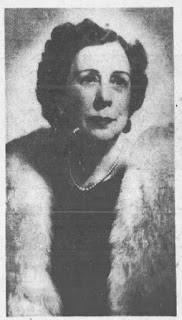The First Spiritualist Church of Miami was incorporated in 1915. The Church met in the home of a member which was located on 909 Avenue C. By 1920 there were four Spiritualist Churches meeting regularly each Sunday; by 1930 there were seven, and by the 1950s there were about 10 Spiritualist Churches meeting each Sunday in Miami.
One of the most popular of these churches was Beckoning Light Spiritualist Church, founded by Rev. Bertie Lilly Candler.
In an interview Rev. Bertie recounted that she began to experience mediumship as a young girl. She experienced clairvoyance and also could see auras. She wasn't particularly frightened by the phenomena but was more worried about being judged about being different. While she kept these experiences a secret from her parents she told her brother about it who encouraged her and affirmed that she was special rather than strange.
While still a young woman she received a message from the spirit world that her beloved Brother would pass away in three weeks from the date of the message. She recounted that she was so distraught she chose to say nothing about it. Three weeks later her brother fell ill and passed away within just two days.
Raised in the Methodist Church, she looked to her Bible for comfort, and felt drawn to a certain page and read the verse "And if I go, I will come again that where I am ye may also be." She stated she felt an inner sense of knowing that her brother would return to her in spirit. In three weeks her intuition was confirmed and she received a message from her brother telling her that she had a mission in life to let others know that their loved ones are never truly gone.
Another story was recorded by Robert G. Chaney in his work Mediums and the Development of Mediumship:
"Bertie Lilly Candler first became interested in Spiritualism in 1918. She was living in Cincinnati, Ohio, at the time. One night her sister-in-law appeared to her in a vision. The sister-in-law was living in the deep south, and Bertie Lilly did not even know she had been ill. She later learned that the sister-in-law had passed away on the afternoon of the same day she appeared in the vision. Just before her passing she spoke to those who had gathered about her bedside. "I want to see Bertie Lilly," was the last sentence she spoke on this earth."
"It was at this time that Spiritualism first offered itself as a possible explanation for all the visions and voices she had seen and heard. She became vitally interested in the movement, began attending services and seances, and then sat in a home developing circle. The third time this circle met, she went into a trance."
"It was just a year later, in 1919, that she began her public career."
The same source is quoted saying, "Bertie Lilly Candler is best known for her work as a materialization medium. She has other phases, too. Trance, trumpet and independent voice. She has practiced her mediumship since 1919. She is a member of the International General Assembly of Spiritualists, and since 1927 has been pastor of the Beckoning Light Church in Miami, Florida."
In 1925 Rev. Lilly came to Miami, and in 1927 she organized Beckoning Light Spiritualist Church. Meetings were held for five years in a Masonic Temple, and in 1942 the Church moved into it's own building at 1621 SW 6th St.
By 1951 Beckoning Light had over 200 members and was perhaps the most prominent and popular Church in Miami. The Church hosted several prominent Spiritualists among it's guest speakers and mediums including Alexander J. McIvor Tyndall and Arthur Ford.
Rev. Bertie also became well known for her somewhat high profile predictions, one of which was supposedly published in a Time magazine Article. Before the outbreak of World War II Rev. Bertie apparently delivered a message from the Spirit of Claude G. Swanson, former secretary of the United States Navy, predicting the United States entering into War with Germany.
In another instance Rev. Bertie hosted a séance attended by Lorenzo Winslow, the interior decorator of the white house, who stated that Rev. Bertie delivered a message from the spirit of Franklin Roosevelt, who stated that there would be an assassination attempt on President Harry S. Truman, but that it would fail. Which then occurred on November 1st, 1950.
The presence of Spiritualist Churches in Miami lasted until about the mid 1950s and early 1960s. Spiritualist Churches as a whole began to decline in the United States, and Miami as a center of American style Spiritualism in Florida began to shift to other areas.
As of 2020 the building that was the home of Beckoning Light Spiritualist Church is now a Pentecostal Church.
The former center of Miami Spiritualism would become a new center for Espiritismo, a form of Spiritualism codified by Allan Kardec into the tradition of Spiritism, which was further developed in the Caribbean and brought to Miami by Cuban immigrants.
Spiritualist, Spiritist, or Espiritista, Miami remains today a spiritual center for those seeking a beckoning light to spiritual advancement.



















.jpg)


